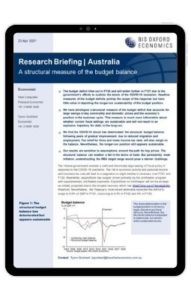Australia | A structural measure of the budget balance

The budget deficit blew out in FY20 and will widen further in FY21 due to the
government’s efforts to cushion the shock of the COVID-19 recession. Headline measures of the budget deficits portray the scope of the response but have little value in depicting the longer-run sustainability of the budget position.
We have developed a structural measure of the budget deficit that accounts for large swings in key commodity and domestic prices and the economy’s position in the business cycle. This measure is much more informative about whether current fiscal settings are sustainable and will not result in an explosive trajectory for debt, in the long run.
What you will learn from this comprehensive 4-page report:
- The structural budget balance has deteriorated but appears sustainable
- Prices can drive large swings in nominal GDP growth
- Structural measures ‘look through’ volatility
- Nominal GDP exceeded its structural level for many years, boosting revenue
Tags:
Related Services

Post
Nowcast shows wage growth slowing sharply
Our sentiment data, developed with Penta, suggests that UK private sector wage growth slowed sharply in March and early-April. If official data mirrors our sentiment indicator, it should keep the Monetary Policy Committee on track to cut interest rates in the summer.
Find Out More
Post
The euro and depreciation – shake, shake it off
Our new forecast assumes a slower euro appreciation against the dollar over the coming years than we previously anticipated. Relative productivity, terms of trade, and the current account will likely be less supportive of the euro than we thought. In addition, a stronger stock market than initially envisaged will attract more financial flows into the US than we had expected.
Find Out More